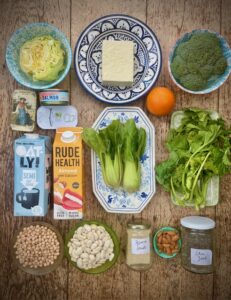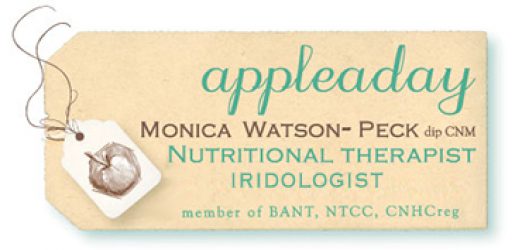I’ve never been a fan of numbers, not in maths at school nor in my work as a nutritionist. Counting calories, for instance, has not been a tool I’ve wanted or needed when helping people gain or lose weight. Not only can calorie counting rob food of its delight and purpose, but it can morph into an unhealthy preoccupation, become disordered, turning into a cause of mental distress. There are far easier and more enjoyable ways to lose or gain weight.
Back to numbers. Despite all the above proclamations I have been counting over the past month, not calories or days till our hols, but milligrams of calcium.
This is mainly due to two women I saw in clinic, both of whom have osteopenia (reduced bone density) and are concerned about the progression to osteoporosis, a disease of serious bone loss and fragility. This alerted me, among other alerts, to their calcium intake.
Both their food diaries showed a distinct lack of calcium foods. One woman, in her early fifties, is lactose intolerant and therefore not eating dairy (dairy being the biggest calcium source, although admittedly not always well absorbed due to other health factors).
The second client, in her early sixties, is following a vegan diet which, again, lacks these dairy sources, but is also low in the stand-out calcium-rich vegetables, and too high in spinach intake – a calcium blocker – and low in fortified plant yoghurts or mylks.

Osteoporosis is known as the silent killer. We don’t know we have it, that we’re losing bone, until we fall or simply trip, and end up with a fracture. Or a tooth falls out, or gum disease is advanced. Our blood and body tissues require stable calcium levels, so if we’re not ingesting/absorbing enough calcium from food our bodies will rob calcium from our stores, namely from our bones. Back pain, a stooped posture, loss of height, these are all possible early signs of bone loss before that fracture happens, so, if this speaks to you, or if osteoporosis is in the family, I’d recommend asking for a bone density scan to assess your risk.
Women, especially menopausal women over 50, are more susceptible to osteoporosis (bottom line is that our bone-protective oestrogen does a dive in menopause). Other reasons for this susceptibility include lifespan – women tend to live longer than men – and also women generally have smaller, more delicate bones which means less mass to lose without consequences.
However, diet, gut health, hormones, inflammation, genetics, exercise, all play a role in bone health, so if any of these are stacked against you then, male or female, you may be susceptible. An excellent book about osteo by someone who had it is by Keith McCormick , a male, case in point.
Back to counting.
Ideally, if you’re a woman over 50, you want to aim for 1200 mg daily calcium intake. For women between 19 and 50 years it’s 1000 mg; for men 19-70 it’s also 1000 mg. And after 70 years, 1300 mg is the recommended daily intake for both men and women.
There are many books on osteoporosis with meal plans and recipes which will be looking at the total picture and which I’d highly recommend for anyone concerned about their bones. However, if it’s calcium alone that you’re now thinking about because perhaps you don’t eat dairy, or you’re wondering whether you should supplement, there are online calcium calculators, a free way of working out your daily calcium intake. These calculator sites are not an exact science, I’ll say that now. There are some discrepancies between them which I’m assuming are due to variations in growing methods, countries, environmental conditions at source, and processing.
However, the general message is pretty clear. There are some stand out plant-based calcium sources. As far as vegetables are concerned, kale, turnip greens, broccoli, bok choy, chinese cabbage are all leafy greens with high to high-medium calcium levels.
Chickpeas, navy beans, soybeans and white beans have good amounts. Almonds are high in calcium (also high oxalates so go easy), and sesame seeds are high (think tahini paste in dressings, sauces…)
Two dried figs will give a 65mg hit and an orange 55 mg.
In addition, choosing a calcium fortified plant mylk or plant yoghurt will make a big daily difference.
And if you eat animal protein, a small can of sardines in your lunch salad will pack a big punch, more than canned salmon with bones, which is nonetheless a good source. Eggs surprise me as they give us so much, but here they offer very little calcium (unless you munch on the shell, which I’d not recommend),
These above-mentioned foods – as well as dairy, of course – kept coming up on various sites. There was good consensus about their calcium worth. I used the International Osteoporosis Foundation calcium calculator list as well as the Bone health and osteoporosis foundation, and an NHS site.
When I couldn’t find some foods I like to eat (samphire or seaweeds), I typed in amount of calcium for that food. I cross checked a few because of some oddities (who the heck is eating uncooked chickpeas or raw butterbeans?); also due to some striking variances in Ca milligram amounts. As stated above, I can only put this down to different sources, growing conditions in different countries/oceans and different processing.
Googling lists, and checking milligram in calcium may feel a bit ho-hum tedious, but you only need to do the maths once, then you have your very own calcium score.
Apart from the above, I’ve listed below a few random high-to-moderate calcium foods to help you get started. Also some info about oxalate foods, which can block calcium. I’ve included a few of the disparate ranges from different sites in the hope that someone out there will find some definitives – let me know please 🙂
A final word, no maths, no counting.
When it comes to health, very little works in isolation. Strong bones are not simply about calcium, but this post isn’t about the other players like magnesium and phosporus, boron, D3 and K2. Nor is it about the importance of gut health and nutrient absorption, immunomodulation, and the gut-brain-bone axis. I’m also not touching on the very essential role resistance or weight-bearing exercise plays, how it stimulates bones, egging them on to remodel and strengthen; the same mindset as use it or lose it, or do or die.
I’ve focused on calcium because it’s so often NOT on our radar, and also because food is a safe way to improve our calcium levels.
Saying that, if your calcium intake remains low even with some food changes, you can now work out how low it is, and supplement accordingly, instead of taking a one-size-fits-all high dose which may cause bloating or digestive issues and potentially lead to hypercalcaemia, kidney stones or possible heart problems. There are a number of calcium supplements which range from low to higher levels. Contact me if you can’t find them.
And if you’d like to read more about bones, the full gamut on how to avoid osteoporosis, the above McCormick book, The Whole body approach to Osteoporosis, is very good. However, there are many other good books out there.
Wishing you all a happy weekend, and if you’re in a sunny place, grab lots of Vit D3. Among many other talents, Vitamin D3 is also a big player in bone health 🙂
Food list:
kale, cooked, 1 cup/c130g = 170-200mg calcium
broccoli, cooked 90g = 50 – 100mg (yes, different lists!)
bok choy, cooked 70g = 160 – 180mg
turnip greens, cooked 52g = 100 – 190 mg
2 dried figs = 65 mg
1 orange = 55 mg
tahini, one tbsp, 15g = 50 – 60mg
tofu, firm, 100g = 120 – 300 mg
plant-based mylk, soy, almond, oat 100 ml = 120mg (a chai latte therefore could be c 240mg Ca)
chickpeas, 100g = 60 – 100mg
soybeans, 150g = 170-470mg (!)
white beans (eg. butterbeans, cannellini beans) 1 cup = 160mg
canned sardines or pilchards, small tin = 350 mg (however I also found a list stating 500mg – due perhaps to different ocean source & processing?)
canned salmon with bones, small tin: 70mg – 200mg (one source, Cheena, a Canadian wild sockeye states a whopping 2000mg for their large 180g can)
almonds, 10 nuts, c 12g = 32mg
sesame seeds, 15g = 100 mg
kelp (like kombu) and wakame, 100g = 150 – 168mg
samphire, 100g = 150mg
Dairy:
cheddar, 30g = 240 mg
fetta, 60g= 270 mg
full fat yoghurt, 170g = 310 – 380mg
semi skmmed milk, 200ml = 240mg
Note: spinach has high calcium content but is also a very high oxalate vegetable, much higher than, say, kale. It is often mentioned as NOT being a recommended calcium source food since oxalates are compounds that bind with minerals, preventing their absorption; minerals such as calcium and magnesium. So it would be wise to eat far less-to-no spinach if you have osteopenia. If you do a search for high oxalate foods you may find you’re eating too many of them daily, so, reducing them would be recommended if you are concerned about bone loss.
